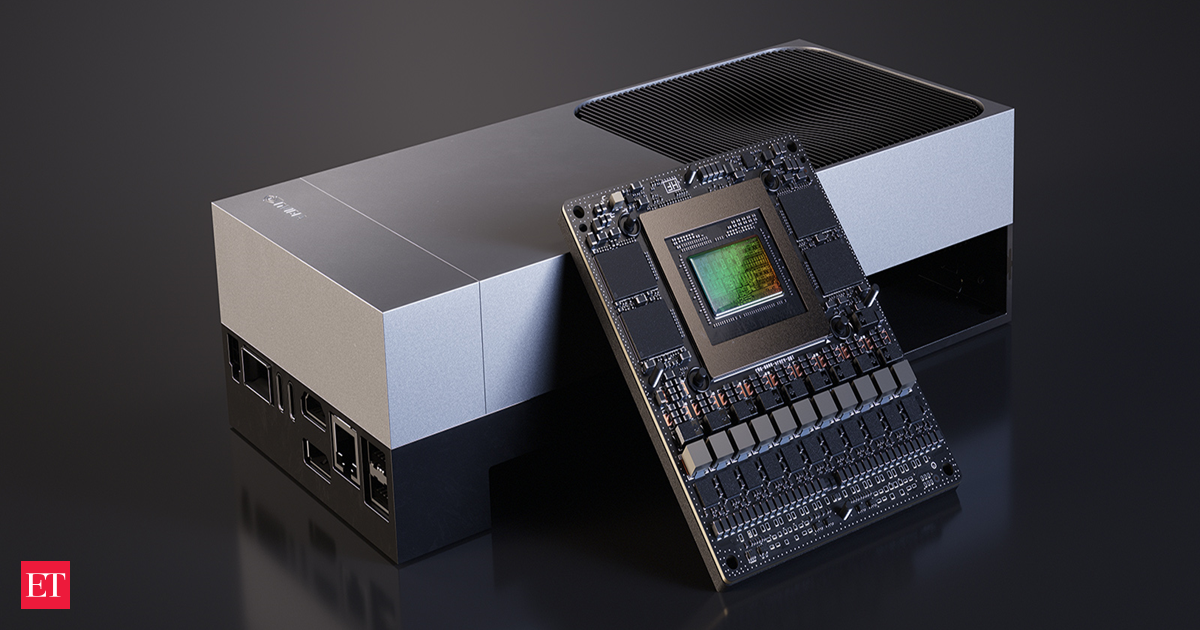New Delhi: Nvidia has unveiled its latest advancement in robotics technology with the Jetson Thor module—a cutting-edge AI chip set to transform the capabilities of humanoid robots. Priced at $3,499, this revolutionary “brain” for robots promises 7.5 times more AI computation and is already attracting significant attention within the tech industry. Set to ship next month, the Jetson Thor enables real-time data processing, potentially accelerating robotics applications across multiple sectors, including logistics and healthcare.
Nvidia’s Jetson Thor: A Revolutionary AI Chip for Robotics
Nvidia has made a groundbreaking announcement with its launch of the Jetson Thor module, an advanced AI chip designed to enhance the functionality of humanoid robots. The Jetson Thor, priced at $3,499, is engineered to provide 7.5 times the AI computing power, 3.1 times the CPU performance, and double the memory compared to its predecessor, the NVIDIA Jetson Orin. This leap in technology positions Nvidia at the forefront of robotic innovation, paving the way for robots that can navigate complex environments with speed and efficiency.
The significance of Jetson Thor extends beyond sheer performance. Nvidia states that this advanced chip will enable roboticists to process high-speed sensor data and perform visual reasoning in dynamic real-world scenarios. “This performance leap will enable roboticists to process high-speed sensor data and perform visual reasoning at the edge—workflows that were previously too slow to run in dynamic real-world environments,” Nvidia highlighted in a blog post. Such advancements open numerous doors for multimodal AI applications and could revolutionize the way robots operate in settings ranging from automated warehouses to healthcare environments.
Applications of Jetson Thor in Various Sectors
The potential applications of Jetson Thor span various industries, most notably logistics, healthcare, and autonomous vehicles. With its enhanced capabilities, the module is set to revolutionize the supply chain sector by enabling robots to perform tasks such as inventory management, sorting, and even delivery within warehouses. Imagine a scenario where robots equipped with Jetson Thor can navigate crowded aisles, identify items, and execute tasks in real time—transforming the efficiency of logistics operations.
In healthcare, the Jetson Thor module’s rapid processing capabilities could lead to more effective surgical robots, capable of making decisions autonomously. For instance, in a hospital operating room, a robot equipped with Jetson Thor could assist surgeons in real-time by analyzing patient data and adjusting its actions based on visual and sensory feedback. This could significantly enhance surgical precision and improve patient outcomes.
Nvidia’s Strategic Vision for Jetson Thor
Nvidia’s CEO, Jensen Huang, envisions the Jetson Thor as a pivotal component in the company’s growth strategy. “We’ve built Jetson Thor for the millions of developers working on robotic systems that interact with and increasingly shape the physical world,” Huang stated. The platform aims to engage a wide range of developers, ensuring that the technology can be adapted for an array of robotic applications.
Included in the Jetson Thor family is a developer kit designed to facilitate experimentation and integration. The kit comes with a Jetson T5000 module, extensive connectivity options, and active cooling solutions, enabling developers to build and test applications more efficiently. The device’s ability to support various generative AI frameworks, including vision language models, expands its utility and makes it more accessible for developers across multiple domains.
Impact on Research and Development
The Jetson Thor is already garnering interest within leading research institutions such as Stanford, Carnegie Mellon, and the University of Zurich. Researchers are leveraging the chip’s capabilities to power autonomous robots designed for medical research and complex tasks. By simplifying the integration of advanced AI into physical agents, the module serves as a bridge between academic innovation and industrial application.
Moreover, as companies adopt this technology, Nvidia anticipates a surge of creativity from its extensive user base, which already comprises more than 2 million developers. As Peggy Johnson, CEO of Agility Robotics, commented, “The powerful edge processing offered by Jetson Thor will take Digit to the next level—enhancing its real-time responsiveness and expanding its abilities to a broader, more complex set of skills.” The combination of performance and scalability suggests that Jetson Thor could fundamentally alter the landscape of robotic capabilities.
In conclusion, Nvidia’s Jetson Thor module represents not merely an incremental improvement in robotic technology, but rather a substantial shift towards smarter, faster, and more capable humanoid machines. As robotics increasingly infuses into everyday life and critical sectors like healthcare and logistics, the Jetson Thor is set to be at the heart of this transformation, unlocking new possibilities for what robots can achieve in the near future.
Bankerpedia’s Insight💡
Nvidia’s Jetson Thor module marks a significant leap in robotics AI capabilities, promising enhanced efficiency across industries like logistics and healthcare. For India’s banking and finance sector, this innovation can transform operational processes, enabling faster decision-making and improved customer services. As banks leverage AI for enhanced data analytics and automation, it’s crucial for financial institutions to invest in these technologies, ensuring they remain competitive. Readers should stay informed about AI advancements and consider how such technologies can streamline their operations and customer interactions in the evolving digital landscape.
What Does This Mean for Me?🤔
- Salaried Person → Increased automation may impact job security and responsibilities.
- Business Owner → Enhanced robotic capabilities improve operational efficiency and scalability.
- Student → Enhanced robotics education and research opportunities for students.
- Self-employed → Increased robotics efficiency may enhance self-employed workflows.
- Homemaker → More advanced robots may assist in homemaking tasks.
- Retiree / Senior Citizen → Advancements may improve eldercare through smarter robotic assistance.
- Job Seeker → Increased competition from advanced AI-powered robotics.
- Farmer / Rural Citizen → Farms may automate tasks, increasing efficiency and productivity.
Research References📚
- economictimes.indiatimes.com
- RBI
- SEBI
- Ministry of Finance
- NABARD
- Department of Financial Services (DFS)
📲 Stay ahead in banking & finance!
Join the Bankerpedia WhatsApp Channel for instant updates, and
subscribe to our YouTube Channel for in-depth analysis and expert explainers.










